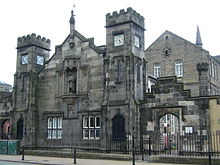- Monitorial System
-
The Monitorial System was an education method that became popular on a global scale during the early 19th century. This method was also known as "mutual instruction" or the "Bell-Lancaster method" after the British educators Dr Andrew Bell and Joseph Lancaster who both independently developed it. The method was based on the abler pupils being used as 'helpers' to the teacher, passing on the information they had learned to other students. [1] The Monitorial System was found very useful by 19th-century educators, as it proved to be a cheap way of making primary education more inclusive, thus making it possible to increase the average class size. The methodology was adopted by the Roman Catholic Church in England and Wales, and later by the National Schools System.
The system is not entirely unlike the way professors, assistants and tutors work together in university education.
The Monitorial System, although widely spread and with many advocates, fell into disfavour with David Stow's "Glasgow System" which advocated trained teachers with higher goals than those of monitors.
Contents
The Lancasterian System
Gladman, writing in the 1880s, distinguishes between the Lancasterian system and the Madras System [2]. The Lancasterian System is described as preferring smaller classes, unlike Bell's Madras System. Lancaster specified an ideal classroom (hall) as being a "parallelogram, the length about twice the width. The windows were to be six feet from the floor. The floor should be inclined, rising one foot in twenty from the master's desk to the upper end of the room, where the highest class is situated. The master's desk is on the middle of a platform two to three feet high, erected at the lower end of the room. Forms and desks, fixed firmly to the ground, occupy the middle of the room, a passage being left between the ends of the forms and the wall, five or six feet broad, where the children form semicircles for reading."
According to Gladman, to stimulate effort and reward merit, "Lancaster used Place Taking abundantly. He also had medals and badges of merit .. Tickets could be earned too; these had a trifling pecuniary value." Prizes were given "to excess" ceremonially.
Frequent changes of routine aided discipline. A code of command, and exact movements also reinforced discipline. Class lists and registers were kept.
Children were classified on a dual principle according to their ability in reading, and arithmetic.
Lancaster described his system as to produce a 'Christian Education' and "train children in the practise of such moral habits as are conducive to the welfare of society."
The Madras System
Bell's "Madras System" was so named because it originated at the Military Male Orphan Asylum, Egmore, near Madras. Gladman describes Bell's system from notes taken from "Bell's Manual" which had been published by the National Society two years after Bell's death, in 1832. "After observing children in a native school, seated on the ground, and writing in the sand .. he set a boy, John Frisken, to teach the alphabet on the same principle .. Bell was consequently led to extend and elaborate the system."
Bell declared "There is a faculty, inherent in the mind, of conveying and receiving mutual instruction." In 1796, John Frisken was 12 years and 8 months. With assistants, he was in charge of 91 boys.
The school was arranged in forms or classes, each consisting of about 36 members of similar proficiency, as classified by reading ability.
The young teachers were kept to task through registers. Reading, Ciphering and Religious rehearsals were tracked through the Paidometer register. Discipline was held through a Black Book, which had entries read to the entire school, and faults were commented on in moral terms.
The hall was built in rectangles, with windows five feet from the floor, but opening at the top. Desks were placed against walls, and the Master's desk was raised, a practice that displeased Gladman, who remarked "Fixing the master thus, deprived him of much of his power; he would do more good in passing from class to class, and teaching."
Development
Despite the many similarities of the two systems, and the initial friendship of Lancaster and Bell, divisions appeared between the advocates. In 1805, a Mrs Trimmer published a paper claiming Lancaster's system was antagonistic to the National Church. It was said that the country was soon divided into two camps; speeches, sermons, magazine articles and pamphlets appeared on each side. The National Society was formed to propagate Bell's System and the B&FSS was formed to propagate Lancaster's System.
See also
- Saber (sectoral currency)
- British Schools Museum (Hitchin), an example of a Lancaster-designed school.
- Sudbury model of democratic education schools.
References
Notes
- ^ monitorial system - Britannica Online Encyclopedia
- ^ School Work Control and Teaching Organisation and Principles of Education by JF Gladman Published Jarrold and Sons 1886
Bibliography
- A Student's History of Education, Frank Pierrepont Graves [1]
- Joseph Lancaster's Monitorial System of Instruction and American Indian Education, 1815-1838, Ronald Rayman, History of Education Quarterly, Vol. 21, No. 4 (Winter, 1981), pp. 395-409 [2]
External links
Categories:
Wikimedia Foundation. 2010.

